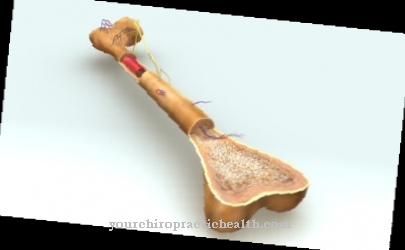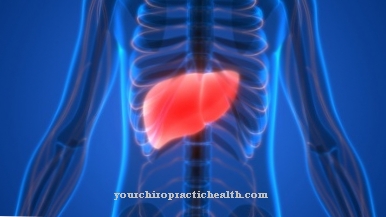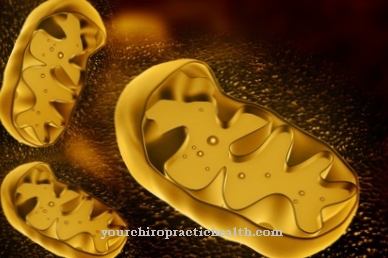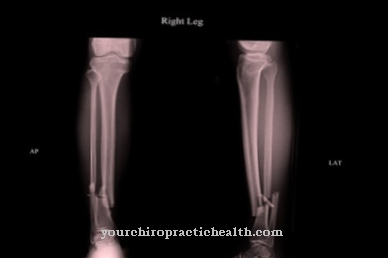With the term contraction (Latin contrahere = to contract) describes the process in which a muscle either shortens or increases its tension. There are different types of contractions with different functional significance.
What is the crown traction?

A muscle can produce two mechanical effects on the human skeleton. Either it stabilizes joints and areas of the body or it moves bones. For this to happen, the force generated in the muscle must be transferred to the bone. The tendons take on this task.
The total muscle consists of several sub-units, such as muscle bundles, muscle fiber bundles, muscle fibers and, at the lowest level, the muscle cells, also called fibrils. In addition to the cell organelles, these contain thousands of sarcomeres connected in series, the smallest functional units of a muscle. Each sarcomere can contract and thus develop strength. The total strength of a muscle results from the sum of the force generated by the sarcomeres involved.
The functional center of each sarcomere are the actin-myosin complexes. Actin and myosin are proteins that are linked together by cross-bridges. The thinner actin strands are attached to the outer boundaries of the sarcomere, the thicker myosin molecules lie between two actin threads.
If a nerve impulse reaches the muscle, calcium is released and the sarcomeres shortened or tensed while consuming energy. The myosin units pull the actin units to the center of the sarcomere by rowing their heads. The effect on the whole muscle depends on how many sarcomeres are made to contract.
Function & task
Contractions produce two effects in the muscle. On the one hand power is developed, on the other hand heat is generated.
The muscles have a poor mechanical efficiency. About 80% of the energy expenditure during muscular work goes into heat development, only 20% into the generation of strength. However, the heat produced makes an important contribution to regulating body temperature and optimizing metabolic processes.
The force developed by the contraction is transmitted via the tendons to the attachments on the bone and either leads to movement in the joints involved or to increased tension. Whether movement occurs depends on the goal that is pursued in the movement programs in the brain and transmitted to the muscles via nerve impulses. If the goal is to carry out movement sequences, all muscle chains that are necessary for the appropriate action are automatically switched on, inhibiting influences are switched off. If a certain position is to be held, the command is to stabilize the muscles, body parts and joints.
The interaction between agonists (acting muscles) and their opponents (antagonists) plays an important role in this process. This creates 3 possible types of contractions.
During isometric contraction, the tension in the muscle increases, but there is no movement because the antagonists or an external resistance do not allow this. Ideally, the agonists and their opponents work together. This form of muscle work is important for all static loads, for example to stabilize the back or the joints.
Concentric contractions cause movement in the joint as the active muscle shortens and the antagonists allow this movement. This form of muscle work is mechanically the easiest and the cheapest to stimulate the muscle metabolism.
Eccentric contractions occur when the muscle controls movements that elongate it. It has to do a lot of mechanical work, because it contracts while the number of cross bridges between actin and myosin decreases. All braking activities belong to this form of contraction.
You can find your medication here
➔ Medicines for muscle weaknessIllnesses & ailments
A typical dysfunction of the muscle and the contraction is muscle weakness (atrophy). It usually occurs because a muscle is not being used enough (inactivity atrophy). This phenomenon is typically observed in bedridden patients or when limbs are immobilized (plaster of paris). The contraction force of the muscles and the muscle cross-section decrease, the function is impaired to a greater or lesser extent depending on the severity and duration. Another trigger for inactivity are injuries or other irritations, for example painful irritation at the tendon attachments. In this case, the brain switches on protection programs that result in muscles being used less. Inactivity atrophies can be regenerated if they do not persist for too long.
The ability of the muscles to contract depends on the nerve stimuli they receive from the brain. If this does not happen, no contraction can take place. The nerve conduction can either be centrally (brain or spinal cord) or peripherally (peripheral nervous system) impaired or completely damaged. The result is incomplete or complete paralysis. Causes for this can be injuries (paraplegia), herniated discs or inflammatory (MS, poliomyelitis) and metabolic diseases (polyneuropathy, amyotrophic lateral sclerosis).
Diseases that impair the ability to contract and have their cause in the muscle itself or at the junction between nerve and muscle are summarized under the term muscular dystrophy. They all have in common the symptoms, possibly visible atrophy, increasing weakness and rapid fatigue. In addition, as the disease progresses, there is often pain when moving, as the strain on the weakened muscles increases. The progressive remodeling in the muscle tissue is also typical of muscular dystrophies. The contractile elements are increasingly being replaced by connective tissue, which not only causes increasing weakness, but also progressive immobility (contracture).
The cause of these diseases are genetic defects that cause irreparable damage to the muscle cells, as a result of which protein formation in the muscle is greatly reduced or completely blocked. Muscular dystrophies are rare diseases that are still incurable today.



























